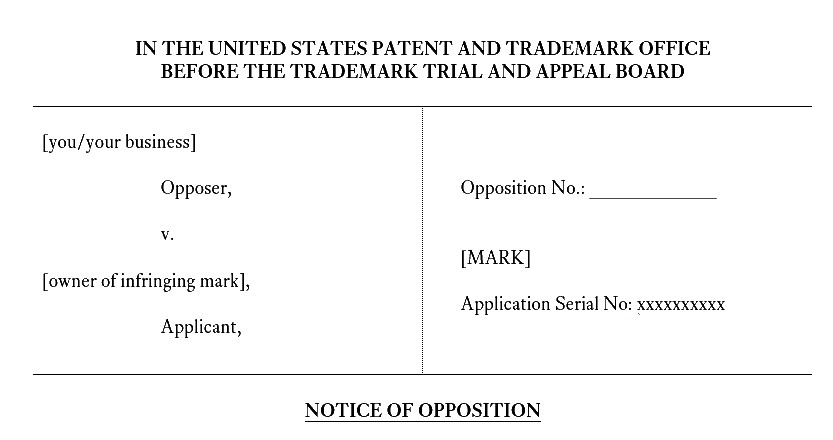

You will also need to pay the TTAB’s government fees. The cost to file an opposition with the USPTO is $600 per class, plus any legal fees. Some trademark applications are for multiple classes – keep in mind that the $600 fee applies to every class, so a five-class trademark application will cost $3,000 in government fees. Those fees are non-refundable and are not returned, even if you win the case.
If you are not a U.S. citizen or if you represent a business outside of the United States, you will have to hire a U.S. attorney to represent you.
Once your Notice of Opposition is filed, the TTAB sets a trial calendar, and the applicant is given thirty days to respond with an answer.
A sample trial calendar can be found below – the calendar can be modified with permission from the Board or with the other parties’ consent:
| Time to Answer | 7/4/2022 |
| Deadline for Discovery Conference | 8/3/2022 |
| Discovery Opens | 8/3/2022 |
| Initial Disclosures Due | 9/2/2022 |
| Expert Disclosures Due | 12/31/2022 |
| Discovery Closes | 1/30/2023 |
| Plaintiff's Pretrial Disclosures Due | 3/16/2023 |
| Plaintiff's 30-day Trial Period Ends | 4/30/2023 |
| Defendant's Pretrial Disclosures Due | 5/15/2023 |
| Defendant's 30-day Trial Period Ends | 6/29/2023 |
| Plaintiff's Rebuttal Disclosures Due | 7/14/2023 |
| Plaintiff's 15-day Rebuttal Period Ends | 8/13/2023 |
| Plaintiff's Opening Brief Due | 10/12/2023 |
| Defendant's Brief Due | 11/11/2023 |
| Plaintiff's Reply Brief Due | 11/26/2023 |
| Request for Oral Hearing (optional) Due | 12/6/2023 |
If the applicant answers, then the two parties proceed to a limited discovery period and trade information about the marks, consumers’ impressions of the marks, and how the marks are used in commerce.
If the Applicant doesn’t answer, then the TTAB orders a “Notice of Default.” After a Notice of Default is issued, the Applicant has an additional thirty days to explain why they did not file an answer. If there is still no response, the TTAB will rule in your favor and typically cancel the mark you are opposing.
Many times, Applicants do not file an Answer because they have reviewed the Notice of Opposition, weighed the risks, and have accepted the outcome. Others may decide that the cost of defending the registrations outweighs the benefits because TTAB proceedings can cost upwards of $5,000 if completed fully.
Below is a chart depicting the number of oppositions filed with the TTAB from the first quarter of 2021 through the third quarter of 2022.
| 2021 Quarter 1 | 1,603 |
| 2021 Quarter 2 | 1,549 |
| 2021 Quarter 3 | 1,706 |
| 2021 Quarter 4 | 1,811 |
| 2022 Quarter 1 | 1,679 |
| 2022 Quarter 2 | 1,591 |
| 2022 Quarter 3 | 1,681 |
If you’re clued in about a filing being made or happen to see a filing you believe will infringe upon your mark, you have an option to alert the USPTO to the issue before they review the application. The first chance to let the USPTO know you believe an application should not be approved is through a Letter of Protest. These are less formal than oppositions because the USPTO handles these, not the TTAB.
The USPTO has a division for attorneys to review the Letters of Protest, and if the attorney who reads your protest believes there is a chance of confusion, they will forward the evidence to the Examining Attorney assigned to the new application. This is a cheaper option than an opposition proceeding and can cause a refusal from the USPTO instead of instigating an adversarial proceeding.
If you miss the publication window, you will still be able to object to the trademark once it has been registered. This is called a Petition to Cancel.
While these procedures can be powerful deterrents to would-be infringers to stay away from marks confusing similar to your trademarks, the USPTO does not have enforcement power. This means that the USPTO cannot stop others from using any trademark in the marketplace. That power is reserved for the courts, and it may be necessary to bring a lawsuit against an infringer to protect your rights.
You should have a comprehensive protection plan for your valuable brands and a good relationship with an experienced attorney to develop and execute it.
By protecting your brand at the USPTO and the marketplace, you can build a strong, valuable brand that represents your business.

Josh Gerben, Esq. is the founder and principal of Gerben IP. In 2008, Mr. Gerben started the firm to provide high-quality trademark services at reasonable prices. Today, he is recognized by the World Trademark Review as a top trademark filer, having registered over 8,000 trademarks. The contents of this blog are for informational purposes only and may not be relied on as legal advice.
Contact an Attorney Today